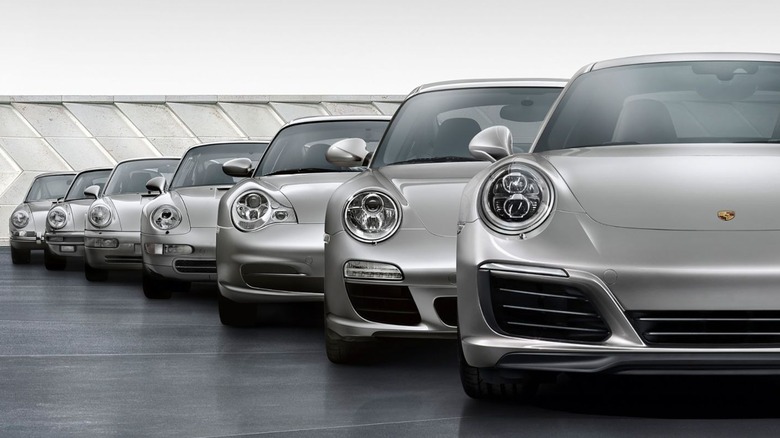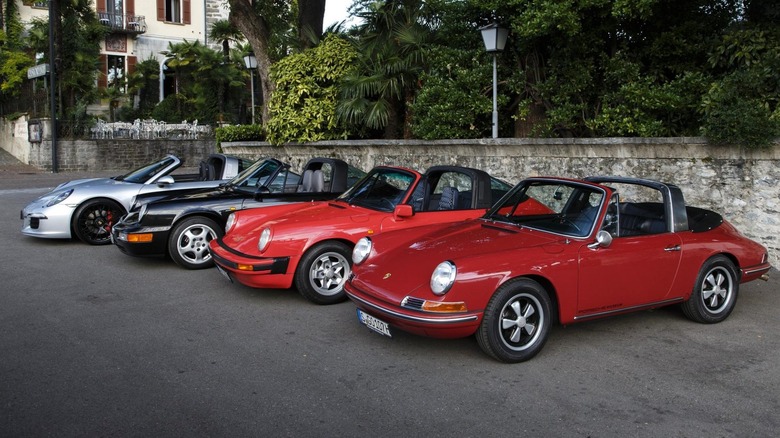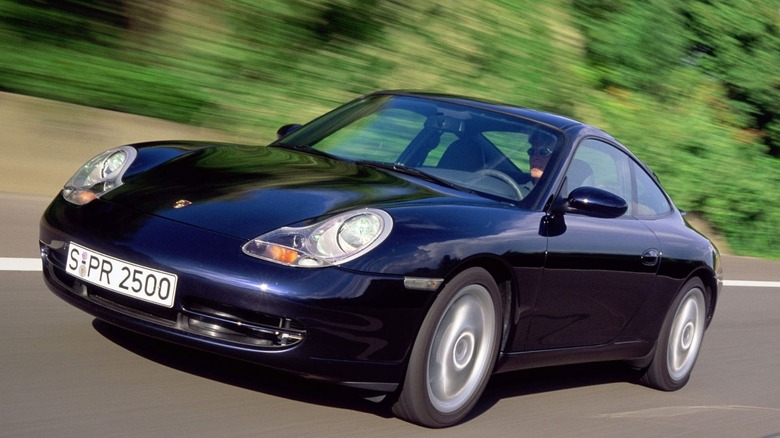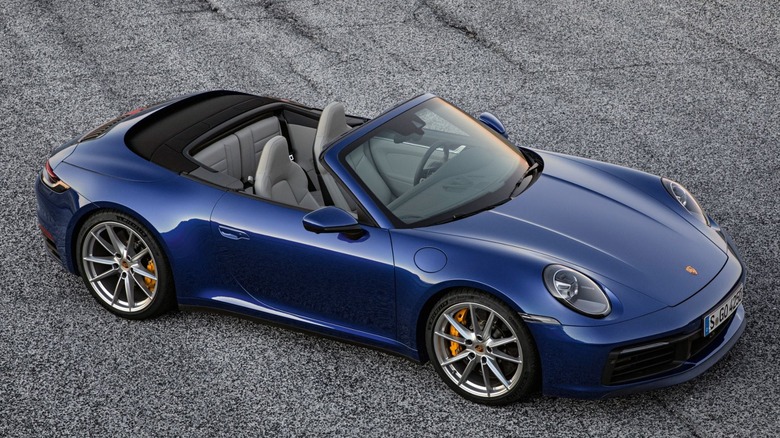How Porsche Has Kept The 911 Alive Through Evolution
Even non-Porsche enthusiasts will recognize the brand's futuristic 928 model as a staple of 1980s films such as "Risky Business," "Scarface," and "Weird Science." You might not know that the front-engine 928 was supposed to replace the iconic yet aging 911, which still had ties to the Porsche 356 model from the early 1950s.
In the two decades following its 1964 introduction, the 911 received refreshed styling with newly-mandated impact bumpers, more creature comforts, a convertible version, and increasingly larger engines — including the availability of a turbocharger — but the car's underpinnings were very much tied to its roots.
While the 928 was successful in its own right, it never eclipsed the demand for the classic rear-engine 911 as intended. Nonetheless, Porsche recognized the need to update its halo car significantly, and it did just that for the 1989 model year. Though the new third-generation 911 (internally known as the 964) didn't appear that visually different from the outgoing model, it was, in fact, an 85% new car, according to Porsche, with much of the technology lifted from the brand's 959 supercar.
Some of those features include the availability of all-wheel drive for the first time, an anti-lock braking system, airbags, power steering, and to the chagrin of hardcore gearheads everywhere, an automatic transmission, dubbed the Tiptronic, was now optional.
The 993 series was the last air cooled Porsche
After only five short years, the 911 platform received another update for the 1994 model year, internally dubbed the 993. Porsche fans didn't realize it then, but this would be the final iteration of the 911 with an air-cooled motor. In hindsight, the 993 is considered by many to be the most attractive and well-rounded of the air-cooled 911s, perfectly balancing heritage and technology.
The 993 is unmistakably a 911 in the styling department, but oblong headlights and an integrated front bumper allow for a lower, sleeker front fascia. The car also featured an all-aluminum chassis for the first time, and the powerful Turbo and Turbo S variants gained standard all-wheel drive, previously only an option for the naturally aspirated Carreras.
Building on the growing demand for automatic transmissions, the Tiptronic was upgraded with a steering wheel-mounted shift paddle. Drivers who still preferred a manual transmission weren't left out, though, because the old-school standard gained an extra gear, now totaling six forward speeds.
Controversial, but necessary changes were underway
By the late 1990s, Porsche, as a company, was struggling financially. If not for the development of new models like the Boxster or, more importantly, the Cayenne SUV, the automaker may well have been snapped up by a competitor. Porsche consulted with Japanese automotive executives to reduce manufacturing costs and return to profit while developing the new fourth-generation 911, the 996.
At the time, the 996 was highly controversial — the flat six-cylinder engine was now water-cooled, considered blasphemy by Porsche fans. Front-mounted radiators and pipes circulated coolant to the still rear-mounted engine.
An optional "whale tail" rear spoiler popular with owners of prior generation 911s was now replaced with an electrically powered spoiler that deployed at higher speeds to increase cooling, then stowed automatically at lower speeds when no longer needed.
One of the Japanese consultants' primary cost-cutting suggestions was for the 911 to share parts with the less expensive mid-engine Boxster, which upset some 911 buyers. The entire front halves of the two cars are identical.
One final indignity was the headlights. While the 911 was already moving away from perfectly round headlights, the 996 series took this idea to the next level with a design — borrowed from the Boxster — which many criticized for looking like fried eggs. Fortunately, Porsche improved the situation with a mid-cycle refresh in 2002 that saw all 911s get the more attractive headlights previously only fitted to the 911 Turbo.
Not only smarter, but larger
For 2005, a heavily reworked version of the 996 was released, the 997, which returned the styling of the 911 closer to its roots. There weren't any huge leaps within this generation, but Porsche Active Suspension Management (PASM) debuted on certain models, as did a dual-clutch "PDK" automatic transmission that was well suited for manual shifting. A Porsche Sport Exhaust (PSE) was also available, which allowed drivers to change the exhaust from a quiet tone to a louder, deeper one remotely.
In 2012, Porsche unveiled the most sophisticated and technologically advanced 911 ever. It was longer and wider than any 911 before it, gaining interior comfort while not sacrificing the nimble handling Porsche is famous for. The manual transmission had seven forward speeds, a first-ever in any car from any manufacturer.
A removable "Targa" roof panel had been a fixture of the 911 lineup for decades, but the sixth-generation 991 elevated the experience with a powered mechanism that cantilevered the entire rear window to allow the roof panel to retract behind the rear seat — all with zero effort from the car's occupants.
Technology we now take for granted began to filter into the 911, including Apple CarPlay and driver assistance features such as automatic emergency braking and forward-collision avoidance. The 991's final party trick was an optional steerable rear axle, which helped the seventh-generation car go around the famed Nürburgring a full 10 seconds quicker than the prior model.
Could an EV or Hybrid be far off?
In 2020, the eighth-gen 911 was introduced, internally coded the 992. Like the relationship between the 996 and 997 series, the 992 is largely a revamping of the 991 rather than a full-scale redesign. A fair bit of freshening up went into the car's cabin, which received an 11-inch touchscreen that owners can use to view the optional night-vision system or 360-degree network of cameras.
On the exterior, flush door handles pop out for use, and headlights with 84 individual LEDs. Nearly all 992 series 911s are twin-turbocharged in the engine compartment, even the models that don't wear the "Turbo" moniker. The difference is that the standard 911 makes 379 to 473 horsepower while the "Turbo" cranks out 572 to 640 horsepower depending on trim level. The only modern 911 to escape the turbo treatment is the race-oriented GT3, which has a larger displacement naturally aspirated flat-six cylinder turning out 402 horsepower.
With the 911 approaching its 60th birthday, it's amazing to observe the advances toward comfort and luxury over the years, all without sacrificing an ounce of performance. The modern 911 is quicker and faster than any generation that preceded it, but thoroughly capable as a daily driver. With the current craze toward Hybrids and EVs, it can't be too long until the 911 joins the fray, but rest assured that if prior adaptation of technology is any indication, Porsche won't abandon the iconic rear-engine sports car's roots.



